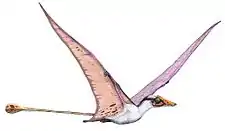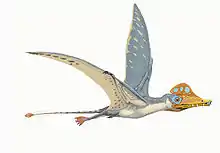Phosphatodraco
Phosphatodraco (meaning "phosphate dragon", in reference to the phosphates of Morocco, the country where it was found) is a genus of azhdarchid pterodactyloid pterosaur from a late Maastrichtian-age Upper Cretaceous portion of the Oulad (or Qualad) Abdoun Phosphatic Basin, Grand Doui, near Khouribga, central Morocco.

| Phosphatodraco | |
|---|---|
 | |
| A comparison of Quetzalcoatlus cervical vertebrae on the left with the Phosphatodraco holotype on the right | |
| Scientific classification | |
| Kingdom: | |
| Phylum: | |
| Class: | |
| Order: | |
| Suborder: | |
| Family: | |
| Genus: | †Phosphatodraco Pereda-Suberbiola et al., 2003 |
| Type species | |
| †Phosphatodraco mauritanicus Pereda-Suberbiola et al., 2003 | |
Phosphatodraco is based on holotype OCP DEK/GE 111, found in 2000, which is composed of five associated, though disarticulated and compressed, damaged cervical vertebrae and a bone of unknown origin. The cervical vertebrae are thought to be a series from the fifth (the longest with a length of thirty centimeters) to the ninth. The individual to which the neck belonged would have had a wingspan of about five meters (16.4 feet). It is unusual among azhdarchids for having elongate vertebrae at the base of the neck (also with neural spines), interpreted as modified dorsal vertebrae; the neck is also one of the most complete known for azhdarchids. It was one of the last pterosaurs before the Cretaceous–Paleogene extinction event that finished off the group, and is the first azhdarchid found in northern Africa. P. mauritanicus is the type and only known species. The specific name refers to Mauretania.[1]
References
- Pereda-Suberbiola, Xabier; Bardet, N.; Jouve, S.; Iarochène, M.; Bouya, B.; Amaghzaz, M. (2003). "A new azhdarchid pterosaur from the Late Cretaceous phosphates of Morocco". In Buffetaut, E.; Mazin, J.-M. (eds.). Evolution and Palaeobiology of Pterosaurs. Geological Society of London, Special Publications, 217. London: Geological Society of London. pp. 80–90. ISBN 1-86239-143-2.
External links
- Phosphatodraco in The Pterosauria













